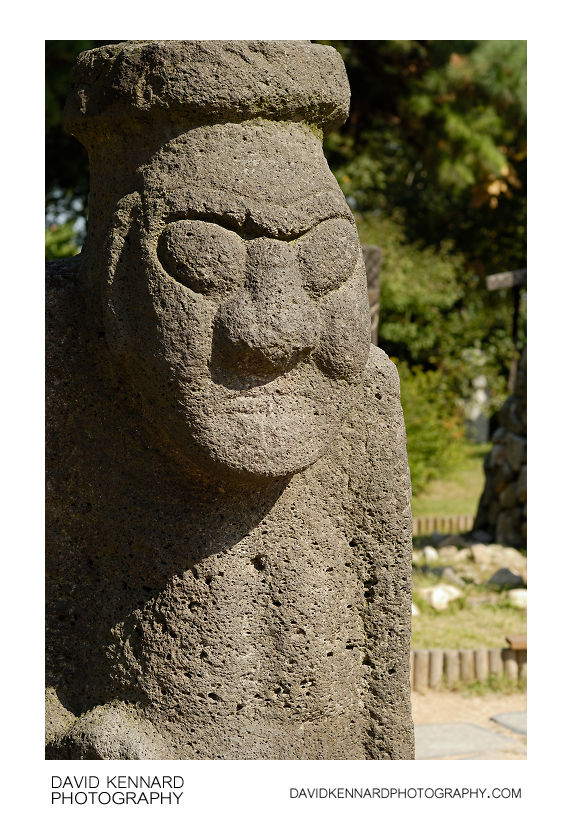Dol hareubang 돌 하르방

Description
- Title:
- Dol hareubang 돌 하르방
- Caption / Description:
-
A stone grandfather, known as a Dol hareubang (돌 하르방) in the grounds of the National Folk Museum of Korea (국립민속박물관), located in Gyeongbokgung Palace (경복궁), Seoul (서울), South Korea (대한민국).
Dol hareubangs, also called tol harubangs, hareubangs, harubangs, are large mushroom-like statues found on Jeju Island off the southern tip of Korea. They are considered to be gods offering both protection and fertility and were placed outside of gates for protection against demons travelling between realities.
The dol hareubangs are carved from porous basalt (volcanic rock) and range in size up to 3 metres high. The statues' faces feature grinning expressions and bulging eyes without pupils, a long, broad nose, and slight smile and their hands rest on their bellies, one slightly above the other. In sets of two, one will have a higher left hand and the other a higher right hand. The hat is commonly referred to as phallic or mushroom-like.
The name dol hareubang derives from the Korean word for "stone" (dol 돌) plus the Jeju dialect word hareubang (하르방) meaning "grandfather" or "senior" (harabeoji [할아버지] in Standard Korean) and was coined in the mid-20th century. Other earlier names for the statues include beoksumeori, museongmok, useongmok. Beoksumeori, meaning shaman head, is used in the former area of Jeongui Hyeon (county), museongmok in Daejeong Hyeon and Jeongui Hyeon, and useongmok only in Jeju Hyeon. Historically, the Tamna Chronicles called them ongjungseok (옹중석/翁仲石) but this usage is unknown today.
There are three main theories as to the origin of dol hareubangs; either that they were introduced by visitors from the sea, that they are a counterpart to the jangseungs (totem poles) of mainland Korea, or that they spread with shamanic mushroom culture. Jangseungs are also called beoksu in southern Korea and this similarity with the name beoksumeori lends credence to the second and third theories.
Halla San has been named in Chinese literature as one of the "Sam Shin San" (삼신산/ 三神山), or one of the Three Spirit Mountains. Each of these mountains are considered gateways to the spirit world, and have the Amanita muscaria growing in abundance. This mushroom is well known by the Siberians and is a possible origin for the Stone Grandfather.
This theory lends that powerful shamans descending from the north established a magic mushroom cult on the island in which stone grandfathers were set at the sides of thresholds to prevent the entry of unwanted spirits.
The mushroom and its related imagery has had great importance in Korea, visible in ancient crowns, funeral urns, the Ship Jang Saeng Do (십장생도). The Dol Harubang are a form of political propaganda, representations of the sacred powers of the mushroom, its associated deity, and attesting to the power of the Shamans.
Dol hareubangs produced from 1763-1765 once stood outside the eastern, western, and southern gates of the Jeju City fortress as guardian deities.
Description from Wikipedia: http://en.wikipedia.org/wiki/Dol_hareubang
- Tags / Keywords:
-
- Stone
- Carving
- Asia
- 한국
- Hanguk
- 韓國
- Korea
- Seoul Special City
- Seoul Teukbyeolsi
- 서울特別市
- 서울특별시
- Jongno-gu
- 종로구
- 鐘路區
- National Folk Museum of Korea
- 국립민속박물관
- Gungnip Minsok Bangmulgwan
- 國立民俗博物館
- Spirit Post
- Village Guardian
- Dol hareubang
- 돌 하르방
Admin
- Date Original Photo Taken:
- Original File Name:
- _DSC7816a.NEF
- Event:
- Rating:
- ☆
- Date this image added/last updated on website:
- Original File Dimensions:
- 2592px x 3872px
- File Type:
- JPEG
- Color Mode:
- RGB
- Original Image Color Profile:
- Nikon Adobe RGB 4.0.0.3001
Location
- Location Shown:
-
- Sublocation:
- National Folk Museum of Korea
- City:
- Jongno-gu
- Province/State:
- Seoul
- Country:
- Korea, Republic Of
- World Region:
- Asia
- Location Created:
-
- Sublocation:
- National Folk Museum of Korea
- City:
- Jongno-gu
- Province/State:
- Seoul
- Country:
- Korea, Republic Of
- World Region:
- Asia
- Geo-location:
- 37.580071469908, 126.97908460972 View on map
Rights
- Copyright Status:
- Copyrighted
- Licensing Status:
- Rights Managed
- Available for Editorial Use:
- Yes
- Available for Commercial Use:
- No
- Copyright Notice:
- © 2009 Dave Kennard
Camera Data
- Date Digital Resource was created:
- Shutter speed:
- 1⁄320 s
- Aperture:
- f/4.5
- Camera Model:
- Nikon D200
- ISO:
- 100
- Exposure Compensation:
- 0
- Focal Length:
- 50mm
- Focal Length (35mm equiv.):
- 75mm
- Metering Mode:
- Multi-segment
- Flash:
- No Flash
- Exposure Mode:
- Auto
- White Balance:
- Manual
- Light Source:
- Cloudy
- Exposure Program:
- Aperture-priority AE
Additional shooting metadata
- Lens:
- Nikon AF Nikkor 50mm F1.4D
- Filters used:
- Additional Optics used:
- Setup:
- Handheld
Post Processing
- Image Modified:
- Software used:
-
- Nikon Capture NX 2
- Post Processing:
-0.61 exposure compensation in Capture NX 2
Highpass sharpen selectively applied in Capture NX 2
